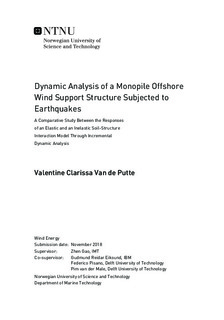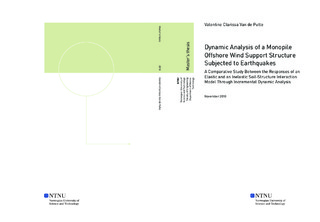| dc.description.abstract | It was shown that the response of the structure is highly sensitive to the amplitude of the earthquake, following a nonlinear increase in response with increasing PGD. Even at the recorded moderate earthquake level, nonlinear effects occurred in the soil-structure system. As such, it is not recommended to assume linear elastic soil-structure response of a monopile for earthquake loads below the Extreme Earthquake Level (i.e. the level generally assumed up to which the structure responds elastically). Because of the presence of nonlinear inelastic behaviour in the soil-structure response under moderate seismic loads, using time history analysis is recommended over spectral analysis as nonlinear effects depend not only on the amplitude but also on the duration and frequency of loading.
Against expectations, the responses of the two soil-structure interaction models were not similar for the as-recorded free-field motion, which was far below the Extreme or Abnormal Earthquake Level and where nonlinear inelastic effects were not expected to introduce dissimilarities between the elastic and inelastic model. This indicated that the ground displacement due to the earthquake motion could no longer be classified as small, and the soil-structure response no longer as linear elastic. This is in disagreement with experiments on slender piles, where observations and experiments in other fields of earthquake research learn that elastic behaviour can be expected for small to moderate ground displacements.
For all earthquake acceleration levels considered in this study, 0.25 g , 0.75 g and 1.17 g , the structure did not meet its ultimate, nor its serviceability requirements when assuming a nonlinear elastic response of the soil. Ignoring the effect of hysteresis and radiation damping proved to lead to a serious overestimation of the loads, response and structural capacity utilisation of the structure, especially below mudline. Energy dissipation should be included in seismic soil-structure interaction modelling, as an elastic assumption puts an excessive demand on the structure.
Load simulations on the nonlinear inelastic model predicted much smaller responses and capacity use of the structure, as radiation damping proved to have an important load-reducing effect. However, it was assessed that radiation damping should only be active during low amplitude loading, when the response of the soil-structure is linear elastic, as otherwise the viscous radiation damper introduced nonphysical excessive dashpot forces that led to unrealistically small pile displacements above mudline. Hysteresis damping should be included to model energy dissipation of the seismic shear waves during large amplitude motion, and the radiation damper should be adapted to only have significant influence during low amplitude motion.
As such, it is recommended to apply either more complex finite-element modelling of the soil-structure interaction, that can incorporate gapping/cyclic softening/liquefaction/hysteresis and radiation damping, or to use a p-y curve approximation that incorporates these nonlinear inelastic effects to a realistic degree. Standardised p-y curves [2], such as the curves used in the nonlinear elastic SSI , were not validated for the use in highly dynamic environments such as earthquake loading, and are hence not recommended to be used in
earthquake-resistance design of monopiles based on the results of this study. | |

